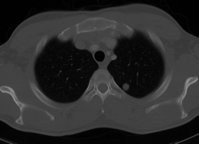Abstract
Adenoid cystic carcinoma is a malignant tumor of the major and minor salivary glands. Because it grows very slowly, it is often diagnosed at a late stage. The combination of a delayed diagnosis and the tumor's propensity for early perineural and hematologic spread increases the risk of local recurrence and systemic metastasis, often many years after the primary tumor has been diagnosed and treated. Only 80 cases of adenoid cystic carcinoma of the larynx have been previously reported in the literature. We report a new case of laryngeal subglottic adenoid cystic carcinoma in a 12-year-old boy.
Introduction
Adenoid cystic carcinoma is a malignant tumor of the major and minor salivary glands. In the larynx, these tumors usually arise in the subglottis or supraglottis, these areas having a large number of minor salivary glands. Two-thirds of these tumors are subglottic. (1) Adenoid cystic carcinomas account for less than 1% of all malignant tumors in the larynx, and only 80 cases have been reported until now. (2)
These tumors have a slight predisposition to women, and their peak incidence occurs during the fifth and sixth decades of life. (3) There is no distinct risk factor that predisposes patients to this malignancy. In this article, we describe a new case of laryngeal adenoid cystic carcinoma, and we discuss its clinical characteristics and treatment.
Case report
A 12-year-old boy was referred to Hazrat Rasoul Akram Hospital with a 6-month history of a slowly progressive exertional dyspnea and stridor. His condition was initially treated as a nonspecific upper respiratory tract infection, but the progressive nature of his disease led to his referral.
The patient had no history of hoarseness, cough, or dysphagia. On physical examination, we noted an expiratory-inspiratory stridor with a distinct expiratory component. Indirect laryngoscopy detected a bilateral, symmetric, submucosal mass in the posterior wall of the subglottic area. The glottic and supraglottic areas exhibited a normal appearance and motion. The subglottic mass was also seen on both plain lateral neck x-ray and axial neck computed tomography (CT). Neither the physica1 examination nor CT detected any evidence of node involvement. Findings on chest x-ray and the results of liver function tests were normal.
We performed a tracheotomy with local anesthesia, then obtained a biopsy with general anesthesia. The pathologist reported that the specimen had a cribriform pattern and was consistent with an adenoid cystic carcinoma (figure). We performed a narrow-field total laryngectomy without neck dissection. Ten days postoperatively, the patient was discharged. At the 20-month follow-up, there was no evidence of recurrence or metastasis.
Discussion
Adenoid cystic carcinoma usually occurs as a largely asymptomatic, nonulcerated, submucosal mass. As a result, diagnosis is often delayed, and subglottic tumors have an opportunity to invade deeply before they are recognized. (1) The clinical behavior of adenoid cystic carcinomas of the larynx mimics that of such tumors elsewhere. Cervical metastasis is rare, occurring in only 10 to 15% of cases. (1) Because early perineural and hematologic spread is common, local recurrences and systemic metastases (especially to the lung) are common and sometimes arise years after the primary tumor has been diagnosed and treated. Therefore, these patients require long-term follow-up. (1,3)
The histopathologic pattern of adenoid cystic carcinoma is classified into three distinct subtypes: cribriform, which is the most common; tubular, which has the best prognosis; and solid, which carries the worst prognosis.
As is true of adenoid cystic carcinomas elsewhere, distant metastases are occasionally stable and slow-growing. Therefore, aggressive local management is recommended, even in patients who have pulmonary nodules. But even despite aggressive management, the 5-year survival rates for patients with laryngeal adenoid cystic carcinoma have been reported to range from only 12 to 17%. (4)
In view of the rarity of laryngeal adenoid cystic carcinoma, there is little in the way of consistent information reported in the literature with respect to treatment. Previous case reports contain different management strategies and few data on follow-up. Yet most authors do agree that the treatment of choice is wide local excision (a partial or total laryngectomy, depending on the location and size of the tumor). In the absence of neck metastasis, elective neck dissection is not necessary. Radical neck dissection is indicated for patients who have clinically or histologically confirmed nodal metastasis.
The role of radiotherapy is controversial. These tumors have been shown to be radiosensitive but usually not radiocurable. Therefore, radiotherapy alone usually has little role in treatment. (4) It is possible that radiotherapy can cure adenoid cystic carcinoma in a prepubescent larynx, but it carries a risk of causing a fibrotic infantile larynx and leaving the patient with no useful voice, airway, or swallowing function. (1) Therefore, we treated our patient with a total laryngectomy without neck dissection, and we did not refer him for postoperative radiotherapy.
References
(1.) Cummings CW, ed. Otolaryngology-Head and Neck Surgery. 3rd ed. St. Louis: Mosby, 1998.
(2.) Morais Perez D, Cortejoso Hernandez A, Borau Clavero M, Martin Siguenz G. [Adenoid cystic carcinoma of the larynx]. Acta Otorrinolaringol Esp 1999:50:660-3.
(3.) Ferlito A, Barnes L, Myers EN. Neck dissection for laryngeal adenoid cystic carcinoma: Is it indicated? Ann Otol Rhinol Laryngol l990;99:277-80.
(4.) Olofsson J, van Nostrand AW. Adenoid cystic carcinoma of the larynx: A report of four cases and a review of the literature. Cancer 1977;40: 1307-13.
COPYRIGHT 2002 Medquest Communications, Inc.
COPYRIGHT 2002 Gale Group



